Creating a hit song is super exciting, but it can also be challenging.
To be a great songwriter, you’ll need to create captivating melodies, write powerful lyrics, and build a solid song structure.
Plus, you’ll have to make sure your production quality is on point and your song is up to industry standards before releasing it.
So, as an artist or music producer, knowing how to make a hit song from scratch is essential for standing out in the competitive music scene.
In today’s article, we’ll be breaking down:
- How to make a hit song ✓
- Key ingredients for songwriting success ✓
- Song structures & the songwriting process ✓
- Creating your signature sound ✓
- How to write lyrics like a true song writer ✓
- Rhyme schemes, themes, and stories ✓
- Creating memorable melodies ✓
- Turning bad songs into great songs ✓
- Enhancing your songwriting skills ✓
- Utilizing major and minor chords ✓
- Layering sounds and instruments ✓
- Mixing and mastering for impact ✓
- Innovative sound design ✓
- Songwriter tips, tricks, and techniques ✓
- Preparing your music for streaming services ✓
- Much more about how to make a hit song ✓
After this article, you’ll know everything about how to make a hit song, from start to finish, and what to do after your songs written.
This way, you can captivate your audience and stand out as a great songwriter.
Plus, you’ll be able to produce tracks with confidence and creativity 一 making sure your music leaves a lasting impression.
Side note, we usually write mainly for producers, but this one is for artists/songwriting enthusiasts as well (we’re writing from both perspectives).
So, let’s dive in so you can learn how to make a hit song…
Table of Contents
Understanding the Basics of How to Make a Hit Song

Whether you want to start writing or you’ve been writing for years, creating a hit song starts with understanding the main songwriting elements that listeners respond to.
The key ingredients for songwriting success include a:
- Captivating melody
- Relatable lyrics
- Solid song structure
Start with a captivating melody that is simple, memorable, and easy to sing along to; think of catchy hooks like those in popular tracks.
Relatable lyrics are essential, so try drawing from a personal experience, or just use more universal themes (heartbreak, revenge, love, etc.).
Whatever helps you really connect with the vast majority of your audience on an emotional level; one line could change everything.
And remember, a strong song structure is key, following a songwriting format like verse-chorus-verse-chorus-bridge-chorus to help things flow smoothly.
Finding a unique angle, like an innovative music production technique or a distinct vocal style, can also make your song really stand out, which can be difficult these days.
High-quality sound and professional mixing and mastering are non-negotiable.
Use EQ and compression to achieve clarity and balance 一 ensuring that each element, from vocals to basslines, is show-stopping yet harmonious.
Layering different instruments and sounds can add richness and depth, but avoid overcrowding the mix to maintain coherence.
NOTE: Experiment with blending different genres and influences to create a fresh, appealing sound that was never heard before.
Finally, focus on your song’s arrangement to build momentum and keep the listener engaged, making sure to include dynamic peaks and valleys.
Don’t worry, we’ll be breaking it all down in detail so you can really understand how to make a hit song that doesn’t just get drowned out.
Building a Strong Song Structure
A solid song structure is key for keeping people invested and really conveying your song’s story. Plus, understanding song structures of most hit songs can help you break the rules efficiently as well (which is where the fun begins). So, let’s dive into the key sections of a well-structured song.
-
Intro: Setting the Tone
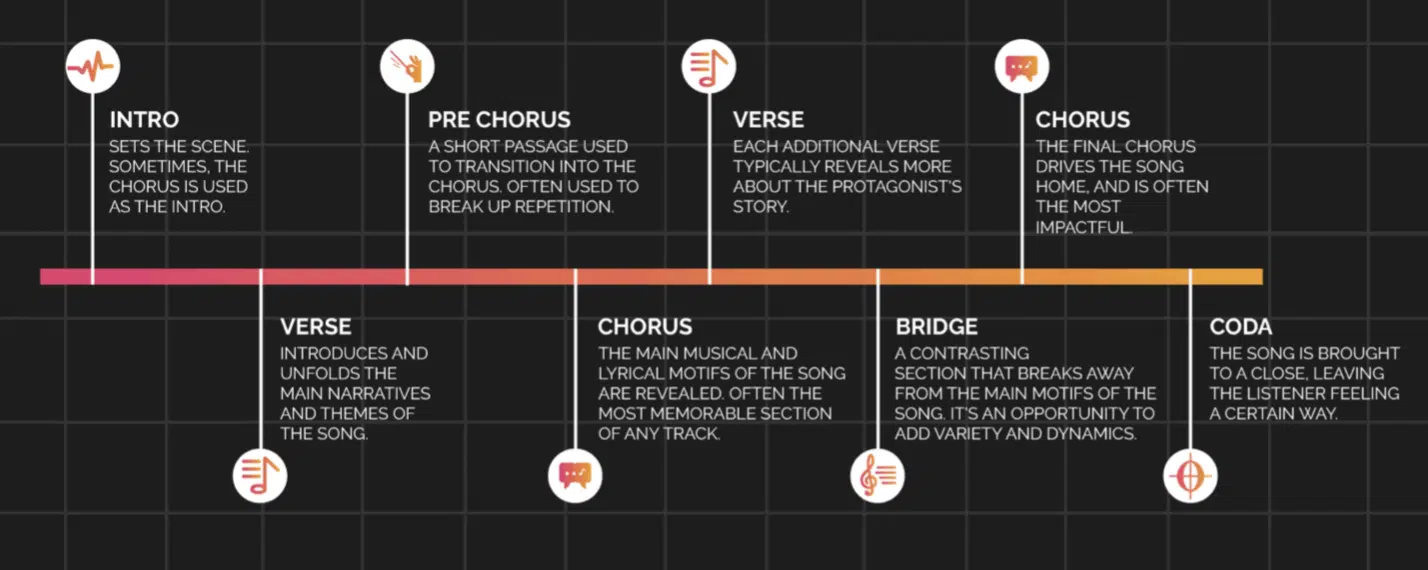
The intro sets the stage for the entire song, both lyrically and musically.
For an artist, it’s the moment to establish the song’s theme and grab the listener’s attention with engaging lyrics.
As a music producer, you need to create a captivating beat or melody that immediately hooks the listener.
Some things that can make your intro instantly addicting are a:
- Simple chord pattern
- Catchy riff
- Unique sound effect
The intro should be concise yet impactful 一 creating a strong first impression.
Try starting with a distinctive instrument or sound that sets the mood for the song and matches the vibe you’re trying to get across.
Combining an intriguing lyrical opening with a powerful musical hook can set the tone effectively.
The goal is to intrigue the listener and draw them into the song’s journey.
-
Verses: Building the Story
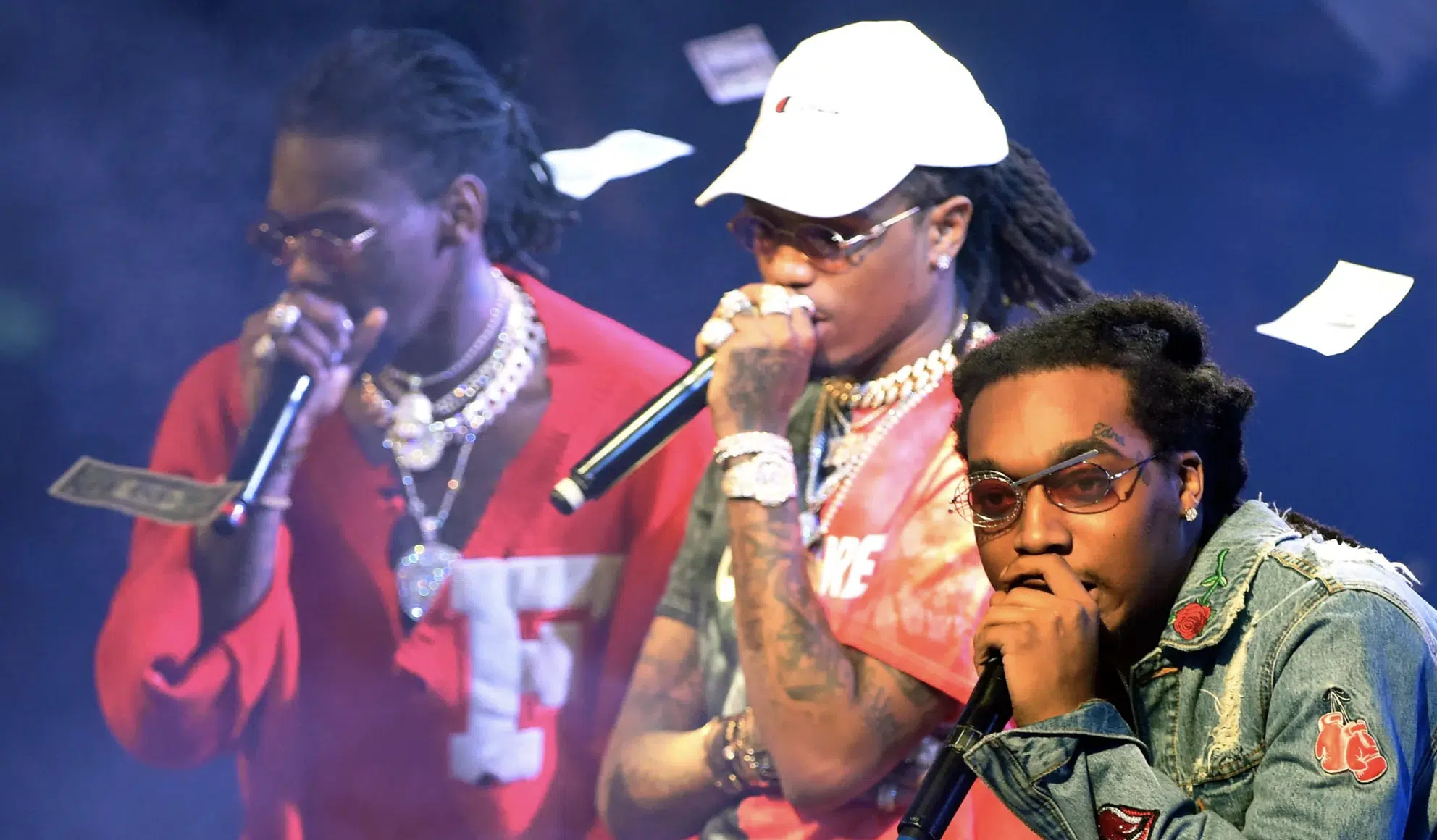
Verses (from the first verse to the last) are where the song’s story unfolds, providing more context and detail to make people stop and listen when they hear it.
From an artist’s perspective, this is the opportunity to really build the narrative, getting personal and reeling people in to whatever vibe you’re going for.
Producers should focus on supporting the lyrics with complementary instrumentation, to ensure the beat evolves to match the storytelling side.
Each verse should build upon the previous one, adding depth and progression to the overall songwriting vision.
When it comes to theme and tone, consistency is key.
You should balance detail with simplicity to make sure the verses enhance the overall structure and introduce subtle changes rhythm to keep the music dynamic.
Structuring your verses to gradually reveal more of the story keeps the audience invested in your song.
-
Pre-Chorus: Creating Anticipation
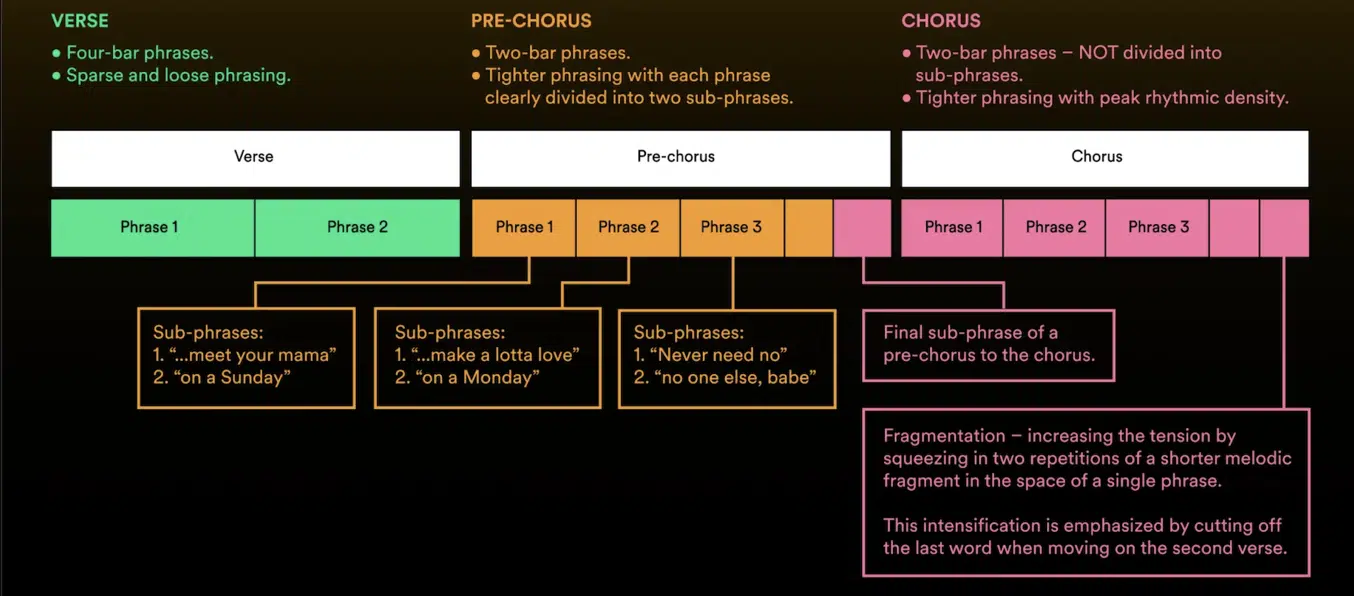
The pre-chorus is the link between the verse and the chorus, building anticipation and excitement that people go crazy go.
Artists can use this section to heighten the emotional tension 一 preparing the listener for the song’s main hook.
Producers should focus on creating a slight change in melody or rhythm to create a sense of buildup.
To enhance this effect, you can try:
- Adding harmonies
- Increasing volume
- Incorporating new instruments
A strong pre-chorus contrasts with the verses, making the chorus more impactful 一 adding to that essential give and take.
Try switching up the chord progression too, which can help create more tension.
This buildup should lead smoothly into the chorus for a seamless transition.
NOTE: The pre-chorus often contains some of the song’s most signature lines and musical moments because it really gets people hype for some energy/momentum.
Picture what you hear on most TikTok videos… a lot of the time it’s a pre-chorus that drops into the hook.
-
Chorus: The Heart of the Song

The chorus is the most memorable part of the song, featuring the main hook.
For most musicians, this is where the song’s main message is delivered, using simple and impactful lyrics that really pack a punch.
Focus on creating a powerful, catchy melody that listeners can easily sing along to.
NOTE: Repetition and strong dynamics are key, and the melody should be straightforward yet unforgettable to complement the lyrics perfectly.
Producers can enhance the chorus with fuller instrumentation, additional layers, or increased intensity.
Artists should aim for concise and impactful lyrics that reinforce the song’s theme.
Bottom line, a great chorus can elevate the entire song 一 making it land on the top of everyones playlist.
-
Bridge: Adding Depth

Your bridge provides a contrast to the rest of the song, adding even more variety and depth with different emotions, perspectives, and lyrical angles.
Here is where producers should add new:
- Chords
- Melodies
- Rhythms
This songwriting section is key for preventing basic, boring tracks and making sure your song has the capacity to really hold your audience.
Oftentimes it’s the climax or turning point, I can sum it up by saying it’s distinct yet cohesive with the rest of the track.
You can change things up, even down to the vocal style/vocal effect to make your bridge stand out; anything that includes complexity and richness.
It will ultimately deepen the listener’s connection and help your song blow up.
-
Outro: Leaving a Lasting Impression

When you write a hit song, you can’t slack when you get to the outro… it’s your final chance to leave a lasting impression.
You should incorporate a satisfying (or cliff-hangy) ending when it comes to lyrics, and tie together all the musical elements introduced throughout the track.
An effective outro might repeat the chorus, fade out, or introduce a new musical concept to respark interest and leave them wanting more.
The outro should be just as emotionally intense as your intro was to wrap up and enhance the overall experience of the song.
You should shoot for a conclusion that is so impactful, they’ll want to hit that repeat button all day.
Producers, you can experiment with different techniques, such as gradual fades or sudden dtops, to really highlight that final impression.
It should ultimately provide a sense of closure and completeness, making your song feel well-rounded, polished, and professional.
Writing Captivating Lyrics

Writing captivating lyrics starts with finding your unique angle.
Think about what personal experiences or emotions you can draw from during the writing process so your lyrics will be:
- Captivating
- Relatable
- Authentic
A good way to begin is by brainstorming themes or stories you want to tell.
For example, writing songs about specific life experiences/an emotional experience can add depth and authenticity to your lyrics.
This will make your new hit songs resonate more with average listeners (the masses).
Developing a clear theme or story for your hit songs will help to give your lyrics and direction; guiding you every step of the way.
Break down your story into key points or scenes and decide where each will fit within the song structure; chorus, build up, outro, etc.
Use super descriptive language and vivid metaphors, as a good song will really paint a picture that people can relate to (or, admire and envy).
Using a sick rhyme scheme can also enhance the lyrical flow and make your song more memorable in the long run 一 you want them replaying it in their head.
Experiment with different patterns when you write songs, like AABB, ABAB, or even more complex schemes to find what best fits your song.
As many songwriters would say, it’s all about connecting with the words and saying them with conviction.
Even if the subject is superficial, you want people to believe that it’s your truth.
Melodies and Chord Patterns
I know we touched upon creating captivating melodies and chord patterns, but since they’re the key to writing a hit song, let’s break it down further. This way, you can learn how to make a hit song that skyrockets to the top of the charts. We’ll start with melodies and move on to using major and minor chords properly.
-
Creating Memorable Melodies

When you’re laying down a melody, it’s all about starting with simplicity, so aim for a tune that is easy/fun to sing and will stick in your listener’s mind.
Use repetition and slight variations to create a hook that listeners can latch onto.
When you want to write a hit song, think about the mood you want to convey with your music and use the melody to express that emotion.
Make sure to play around with different scales and modes to find a melody that stands out and you connect with.
Pentatonic scales, for example, are a great starting point for catchy melodies because of their pleasing, familiar intervals.
Try humming your melody and see if it feels natural and catchy when you hear it recording and listening back can also help identify strong/not-so-strong parts.
Also, use dynamics and rhythm to add interest to your melody, like playing with the timing of notes and incorporating strategic pauses.
Crescendos and decrescendos are also great for adding emotional depth.
NOTE: Layering your melody with harmonies or counter-melodies can also make it more compelling, so you might want to try that for your next song.
Remember, the best songs (hit songs, if you will) are the ones that really hit your audience right in the ‘feels.’
-
Utilizing Major Chords and Minor Chords
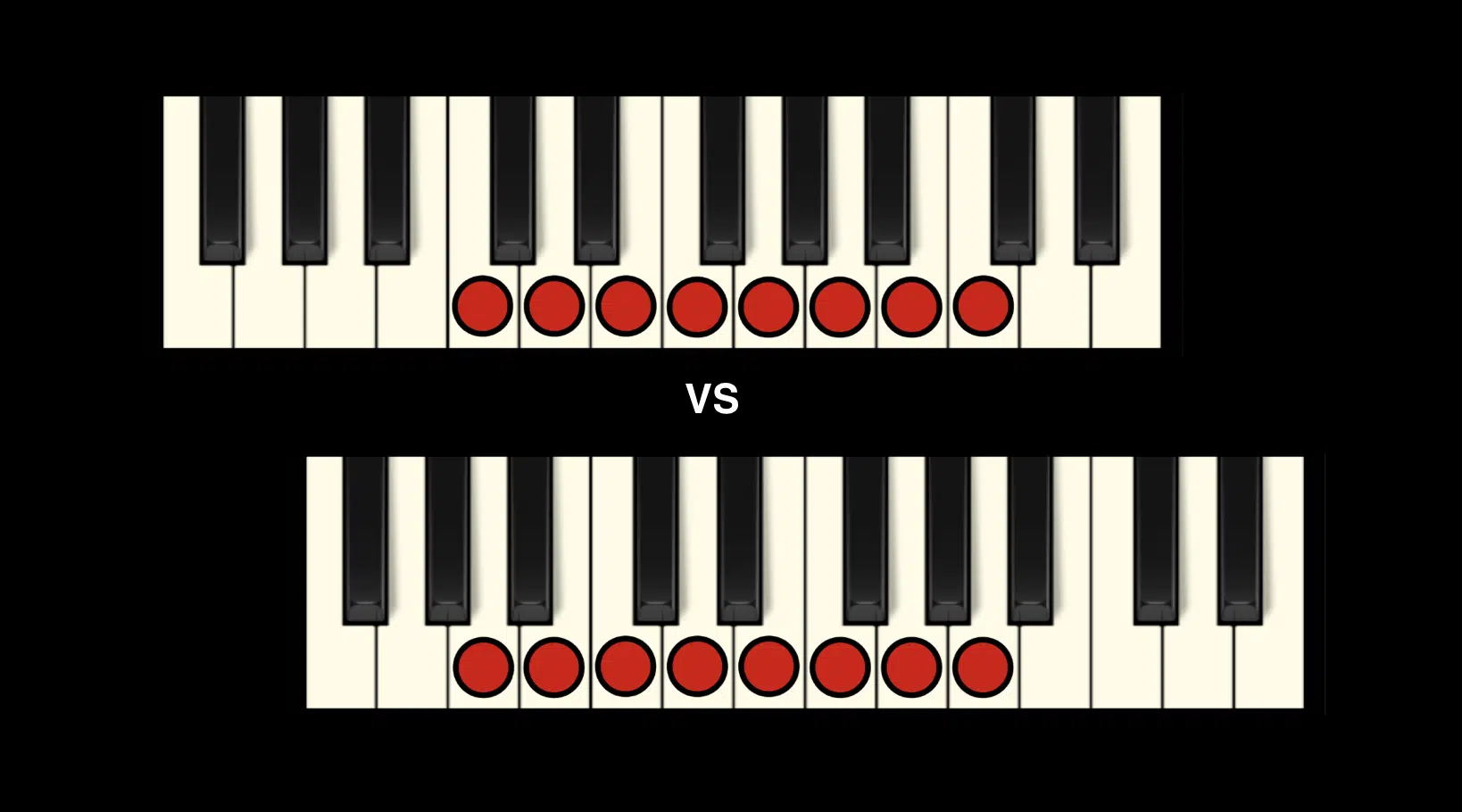
Major and minor chords are the foundation of your song’s harmonic structure, so if you’re learning how to make a hit song, you’ll have to be very familiar.
Major chords often convey happiness and brightness, making them ideal for uplifting sections of your music, like the chorus.
Minor chords, on the other hand, evoke sadness or tension, which can add emotional complexity to your verses or bridge.
You should try switching between major and minor chords to create dynamic shifts in your song, which people really respond to.
To create a balanced progression, trying mixing major and minor chords…
For example, starting with a major chord and transitioning to a minor chord can introduce a sense of conflict or longing.
When you write a hit song, a lot of it rides on tension and release, so you can even throw in some chord inversions to add variety and smooth transitions between chords.
This technique helps maintain a seamless flow and keeps the listener engaged.
Play around with different chord patterns and progressions to find what best suits your melody and gives your song life.
Common progressions like I-V-vi-IV (C-G-Am-F) are popular because they sound pleasing and familiar…
However, never be afraid to deviate from these patterns from one song to the next; you never know what unique sequences and combinations you’ll find along the way.
NOTE: Adding seventh chords or suspended chords is a great place to start.
Remember, songwriting and making music in general is all about thinking outside of the box, happy accidents, and breaking the rules.
Music Production Musts
When you’re learning how to make a hit song, don’t overlook the production value. It’s key for bringing your song to life. Think of the many songs that made you cringe because the production was trash… don’t be that person. Here are some essential tips for music production that can help enhance your hit song.
-
Layering Sounds and Instruments
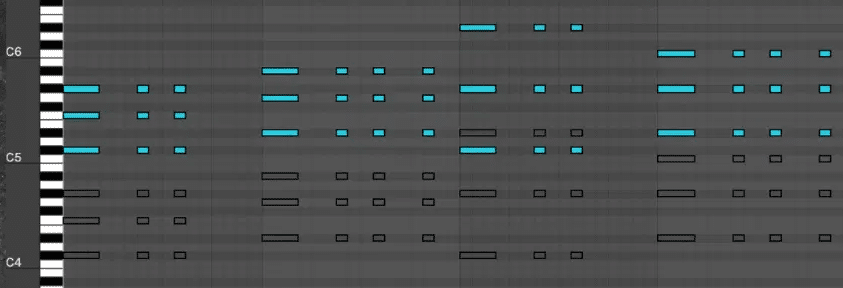
Layering sounds and instruments can add richness and depth to your track, so start by recording multiple takes of the same instrument or vocal line, then blend them together.
Use different panning positions to create a wide stereo image.
This technique can make your production sound fuller and more professional.
Experiment with adding subtle layers, such as a quiet synth pad or background vocals, to fill out the mix.
These additional elements can enhance the overall texture without overpowering the main melody or lyrics.
NOTE: Layering is especially effective in the chorus, where you want the song to sound its biggest and most profound.
-
Mixing and Mastering for Impact

Mixing is the process of balancing all the elements of your track.
Start by adjusting the levels of each instrument to ensure clarity and coherence.
Use EQ to carve out space for each element 一 removing unnecessary frequencies that can cause muddiness.
Compression can help control the dynamics and add punch to the mix, which many songs don’t fully nail down.
Mastering is the final step, where the mixed track is polished and prepared for distribution.
Mastering, which is like the sprinkles on top of already great ice cream, involves:
- Adjusting the overall loudness
- Adding final EQ tweaks
- Ensuring the track sounds good on all playback systems
A well-mastered track can significantly enhance the song’s impact and make it stand out on all streaming services.
High-quality audio is essential for making a strong impression on listeners.
So, before you upload your songs to any streaming services, consider hiring a professional mastering engineer if you’re not confident in your own skills.
Remember, the main point when you’re learning how to make a hit song, is it should always be pristine, from start to finish.
-
Effects & Sound Design

Effects such as reverb, delay, and modulation can add depth and interest to your track.
Use reverb to create a sense of space and delay to add rhythmic complexity and modulation effects (chorus, flanger, etc.) can add movement and texture.
Experiment with different effect settings to find what enhances your song.
For example, a subtle reverb on vocals to create an ethereal quality or a rhythmic delay (to a guitar riff) to give it a bouncing, echoing effect that complements the beat.
Sound design involves creating unique sounds that can set your track apart.
This can be done using:
For example, you might design a signature synth lead using a combination of oscillators and filters.
Layering different sound textures can also create a mesmerizing, dynamic soundscape.
Experiment with different sound sources, such as field recordings or more instruments that are unconventional, to add originality to your track.
NOTE: Adding subtle effects like reverb or delay can enhance these sounds and integrate them smoothly into your mix.
Creative sound design can make a great song legendary and unforgettable.
How to Make a Hit Song: Final Thoughts
Learning how to make a hit song is not as simple as it sounds.
You have to master the art of writing captivating lyrics, laying down unforgettable melodies, and structuring your song like a pro.
Plus, make sure your production quality is top-notch, your mix is balanced, and your song is ready for release on streaming platforms.
This way, your tracks will always be polished, engaging, and ready to upload.
For those looking to become the absolute best songwriter they can be, you have to check out the world’s top Songwriting Secrets course.
It contains industry secrets to writing hit songs from start-to-finish just like the professionals do (invaluable!).
It’s the key to creating impactful songs, effortlessly writing impressive melodies, getting your music heard, and so much more.
Even if you don’t know the first thing about music theory, you’ll be knocking out hits left and right, guaranteed.
Needless to say, if you’re learning how to make a hit song, there’s no better resource.
Now, go put your new songwriting knowledge to the test and create songs the world can’t forget and the industry will surely notice.
Until next time…







Leave a Reply
You must belogged in to post a comment.